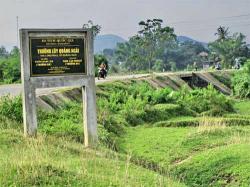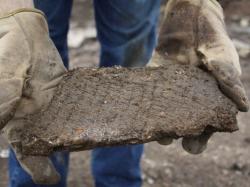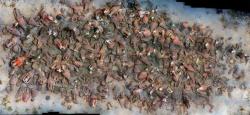INSTITUT SUPERIEUR D'ANTHROPOLOGIE
INSTITUTE OF ANTHROPOLOGY
ONLINE COURSES / COURS A DISTANCE
SPRING TERM : APRIL 2014
REGISTER NOW
VIET NAM –  Tan Long Ha - The archaeologists, including Italian Federico Barocco and French Beatrice Wisniewski, uncovered pieces of pottery and ceramic jars, pots and bowls dating back to the 18th-19th centuries.The antiques, originating from China and the north of Viet Nam, were proof that trade had existed between the locals and residents in different regions. The military post, where the troops were stationed, was a part of the Truong Luy (Long Wall) vestige. The 30m-long stone military post had a ditch system to protect Truong Luy. The 200km-long Truong Luy, built from a combination of soil and stone, was the greatest engineering feat of the Nguyen (1802-1945) Dynasty. The rampart has long been considered as one of Asia's largest ramparts, including fortifications, roads, and military posts. The excavation, presided by PhD Nguyen Tien Dong, will be carried out until April 25. "We also found coal ashes and burn marks on the newly discovered objects that proved the existence of a quite large kitchen," Dong stated.
Tan Long Ha - The archaeologists, including Italian Federico Barocco and French Beatrice Wisniewski, uncovered pieces of pottery and ceramic jars, pots and bowls dating back to the 18th-19th centuries.The antiques, originating from China and the north of Viet Nam, were proof that trade had existed between the locals and residents in different regions. The military post, where the troops were stationed, was a part of the Truong Luy (Long Wall) vestige. The 30m-long stone military post had a ditch system to protect Truong Luy. The 200km-long Truong Luy, built from a combination of soil and stone, was the greatest engineering feat of the Nguyen (1802-1945) Dynasty. The rampart has long been considered as one of Asia's largest ramparts, including fortifications, roads, and military posts. The excavation, presided by PhD Nguyen Tien Dong, will be carried out until April 25. "We also found coal ashes and burn marks on the newly discovered objects that proved the existence of a quite large kitchen," Dong stated.
http://english.vietnamnet.vn/fms/art-entertainment/99054/traces-of-a-wartime-kitchen-found-in-central-province.html
PAKISTAN - Mohenjo-Daro - The ‘Dry Core Drilling’, the technical and scientific process of determining the limits of archaeological site of Mohenjo-Daro was launched/inaugurated by Mr. Bilawal Bhutto Zardari, Patron-in-Chief, Pakistan People’s Party on Apr 5, 2014. It is first ever indigenous Mega effort at the Mohenjo-Daro after 1965 almost 50 years back.The process of Dry Core Drilling includes drilling/coring up to 20 meter deep. The detailed study of core (soil) will be carried out at Moenjo-Daro by the experts of Archaeology and sedimentology to identify cultural and natural layers. Based on the preparation of core logs, sedimentlogical lab analysis and interpretation final assessment about the areal extent of Mohenjo-Daro remains will be carried out.
http://pakobserver.net/detailnews.asp?id=238711
USA –  Nashville - Prehistoric artifacts found at the Sulphur Dell construction site are adding another chapter to Nashville's history.State archaeologist Mike Moore said crews first unearthed the prehistoric deposits, which could date back as far as 1150 AD, last month in the area that will one day become left field for the Nashville Sounds. Archaeologists' work at the site wrapped Wednesday so that construction could continue. Fire pits and broken pieces of ceramic pans uncovered at Sulphur Dell suggest that there was a large workshop there where mineral water was boiled to collect salt, a valuable trading commodity. This is the first discovery of its kind in the region, Moore said.
Nashville - Prehistoric artifacts found at the Sulphur Dell construction site are adding another chapter to Nashville's history.State archaeologist Mike Moore said crews first unearthed the prehistoric deposits, which could date back as far as 1150 AD, last month in the area that will one day become left field for the Nashville Sounds. Archaeologists' work at the site wrapped Wednesday so that construction could continue. Fire pits and broken pieces of ceramic pans uncovered at Sulphur Dell suggest that there was a large workshop there where mineral water was boiled to collect salt, a valuable trading commodity. This is the first discovery of its kind in the region, Moore said.
http://www.wbir.com/story/news/2014/04/04/nashville-ballpark-build-unearths-ancient-finds/7294175/
SUISSE –  Nyon - Nouvelle découverte archéologique au centre-ville de Nyon. Le long de la rue Jules Gachet, sur le chantier du futur hôtel de la société immobilière Norwood, des archéologues ont mis à jour des murs romains datant du 1er siècle. Selon les premières observations des spécialistes, ces vestiges sont en excellent état. "Nous nous attendions à trouver quelque chose", indique Christophe Henny, en charge des fouilles. "Nous connaissons bien ce secteur pour y avoir fait plusieurs recherches lors de précédents chantiers." La surface mise à jour s'étend actuellement sur 80 mètres carrés. Mais les archéologues, mandatés par la société Archeodunum, prévoient d'étendre leurs recherches sur l'ensemble du chantier. Les fouilles devraient durer un peu plus d'un mois avant que les vestiges antiques ne soient détruits. A moins d'une découverte extraordinaire... - http://www.lacote.ch/fr/regions/nyon/des-murs-antiques-decouverts-au-centre-ville-586-1277672#sthash.OpiCGGDt.dpuf
Nyon - Nouvelle découverte archéologique au centre-ville de Nyon. Le long de la rue Jules Gachet, sur le chantier du futur hôtel de la société immobilière Norwood, des archéologues ont mis à jour des murs romains datant du 1er siècle. Selon les premières observations des spécialistes, ces vestiges sont en excellent état. "Nous nous attendions à trouver quelque chose", indique Christophe Henny, en charge des fouilles. "Nous connaissons bien ce secteur pour y avoir fait plusieurs recherches lors de précédents chantiers." La surface mise à jour s'étend actuellement sur 80 mètres carrés. Mais les archéologues, mandatés par la société Archeodunum, prévoient d'étendre leurs recherches sur l'ensemble du chantier. Les fouilles devraient durer un peu plus d'un mois avant que les vestiges antiques ne soient détruits. A moins d'une découverte extraordinaire... - http://www.lacote.ch/fr/regions/nyon/des-murs-antiques-decouverts-au-centre-ville-586-1277672#sthash.OpiCGGDt.dpuf
CHYPRE –  Mazotos - Since 2007, the University of Cyprus has been conducting excavations on a 4th century BC shipwreck, located off the coast of Mazotos village at the Larnaca District. The shipwreck was found in 2006, almost undisturbed, at a depth of 45 metres. The main cargo of the ship was wine transported in Chian amphorae but there is secure evidence that secondary cargoes were also carried in its hold. Despite the early stage of investigation, important finds related to the ship’s size and gear have come to light, including the lead stocks of three wooden anchors and parts of the keel in the bow and stern area. Moreover, interesting research questions have arisen concerning seaborne trade between the Aegean and the eastern Mediterranean, as the Mazotos ship carried a homogeneous Aegean cargo of amphorae which are not very commonly found on Cyprus. Another important aspect of the project is the application of digital photogrammetry and 3D visual techniques for the mapping and documentation of the excavation. This method opens new paths for the analysis of shipwrecks, since it minimizes the inevitable distance between the maritime archaeologist and the underwater excavation site, especially in deep waters.Having a detailed 3D model of the site on the computer screen, the Mazotos Project research team can investigate ways to reconstruct the ancient ship, through the detailed study of stratigraphy and the specific location of the finds.
Mazotos - Since 2007, the University of Cyprus has been conducting excavations on a 4th century BC shipwreck, located off the coast of Mazotos village at the Larnaca District. The shipwreck was found in 2006, almost undisturbed, at a depth of 45 metres. The main cargo of the ship was wine transported in Chian amphorae but there is secure evidence that secondary cargoes were also carried in its hold. Despite the early stage of investigation, important finds related to the ship’s size and gear have come to light, including the lead stocks of three wooden anchors and parts of the keel in the bow and stern area. Moreover, interesting research questions have arisen concerning seaborne trade between the Aegean and the eastern Mediterranean, as the Mazotos ship carried a homogeneous Aegean cargo of amphorae which are not very commonly found on Cyprus. Another important aspect of the project is the application of digital photogrammetry and 3D visual techniques for the mapping and documentation of the excavation. This method opens new paths for the analysis of shipwrecks, since it minimizes the inevitable distance between the maritime archaeologist and the underwater excavation site, especially in deep waters.Having a detailed 3D model of the site on the computer screen, the Mazotos Project research team can investigate ways to reconstruct the ancient ship, through the detailed study of stratigraphy and the specific location of the finds.
http://www.archaiologia.gr/en/blog/2014/04/04/ship-sank-everything-lost/